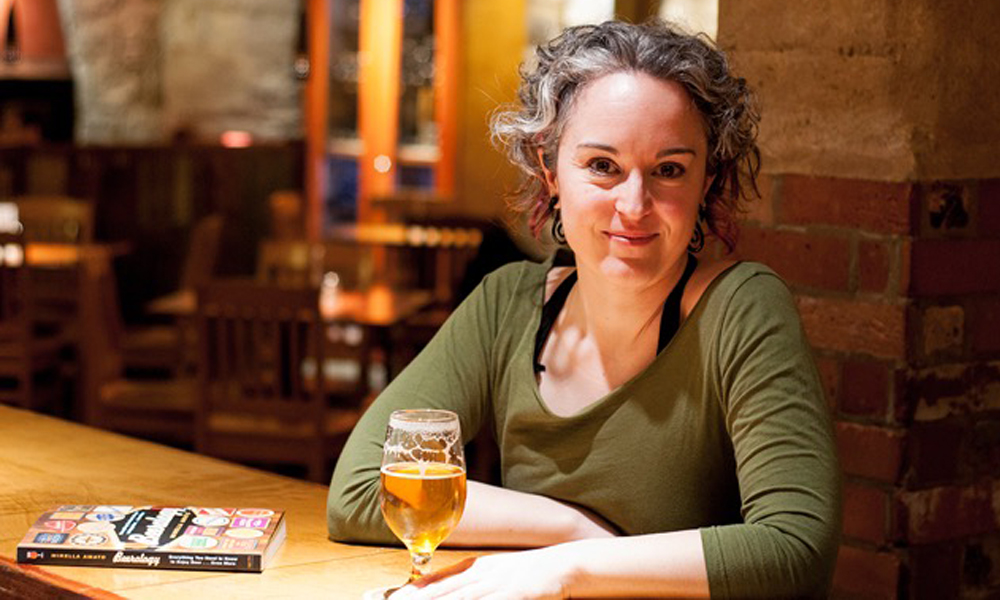In the last five or six years, craft beer has entered a phase often described as “revolutionary.” Small-batch brewers can barely match the pace of consumer demand; traditional styles are constantly being resurrected and redefined; casual enthusiasts are armed with more knowledge than ever before. In an industry teeming with experts, gurus, and connoisseurs, few of them know beer quite like Mirella Amato does.
The Toronto-based author and consultant is one of only 11 people in the world to have earned the title of Master Cicerone, the highest level of certification in the beer industry, and a distinction that only comes after acing an exhaustive 14-hour exam that very few of its takers have actually passed. Before Amato was consulting for bars on their beer programs, leading trainings and tastings, and publishing an exhaustive guide to beer, she was actually an opera singer living and working in Naples, Italy — an unconventional route, to say the least.
Like so many in the industry, it was a path that only presented itself after she hit a hard reset on her life. “I was in a position where I really had to start from scratch,” she says. “After a little bit of searching, I realized, if I’m starting from scratch at this stage, I owe it to myself to follow my passion and see where it leads.” The timing couldn’t have been better: it was 2007, and the nascent craft beer movement was just starting to take root.
At the time, in-depth beer educational programs were sparse outside of the realm of brewmaster training (which Amato tried and, to her surprise, didn’t love). “The thing with [brewing] beer is that it’s an odd mix of hands-on and hands-off, in the sense that you have to make it, and then you have to wait 3 weeks to figure out if it worked or not,” she explains. “Temperamentally, I need a quicker conception to execution time. I’m a tinkerer.” So, she DIY’d her own education by soaking up all the knowledge she could possibly find, developing her palate by taking classes and judging competitions, and talking to as many brewers as she could to try and answer the question: “Where do I fit in with this?”
Fortunately, as the industry grew, so did the opportunities. “There are many cool things about the brewing industry, but one of the things I love is that there’s space for everyone,” says Amato. “The recurring theme that came up with a lot of these brewers was that they were so busy making these beers and getting them out the door, they didn’t really have time to sit down with people and explain these flavors to them.” Thus, Beerology was born: Amato’s education and consulting company, through which she sought to educate everyday pilsner drinkers about the complexities and nuance of craft beer. As the beer industry evolved, so did Amato’s business, adding bar staff trainings and consultation to the mix. She attributes both her passion for beer and her unconventional performance background to her success: she likes to entertain and educate, and in this niche, she could do both.
“We’re shattering people’s preconceived notions of beer.”
The industry has grown by leaps and bounds in the last decade — and for someone who prizes learning new things and sharing them with others, it’s an exhilarating time to be in the epicenter of a revolution. “The number one thing for me that’s exciting is that we’ve gotten to a stage now where, no matter which bar you go to, almost all of them are going to have at least one or two beers outside of that lager spectrum,” she says. “I have nothing against lagers, but I do have something against lack of variety. The fact that it’s everywhere, that people are getting into it, is exciting, because this is why I started in beer: that wasn’t happening, and people were missing out.”
Amato also appreciates how craft brewers are becoming more and more fearless in their willingness to break the mold. While there’s nothing wrong with tradition (she says she’ll never give up her old-school British cask-conditioned ales), the number of small-scale brewers experimenting with things like barrel-aging, sours, and surprising ingredients is forcing the industry to move forward and encouraging its enthusiasts to try new things. “I’ve had beers with salt, lavender, tandoori spices… but they’re really well-executed and complex and delicious beers, not just with something thrown in or completely out of balance,” says Amato. “I think we’re shattering people’s preconceived notions of beer.”
It’s a dynamic that will sound familiar to anyone who’s witnessed the creativity coming out of the cocktail world in recent years. For every brewmaster tinkering with briny goses, chile stouts or funky sours, there’s a bartender experimenting with squid ink, cucumber air and rotovaps. Amato chalks it up to an industry-wide love for discovering new things and sharing those things with new people: at this point, almost a prerequisite for anyone with aspirations of helming a cocktail program or a craft brewery. “If I have to boil myself to the essence of who I am, there are two things that drive me: learning new things, and sharing what I know. If I can be doing something both simultaneously, then that’s the best. That’s what I really find is happening in the cocktail world, too,” she says.
Craft beer is barreling forward at a rapid pace. Cocktail culture has expanded and grown exponentially in the last decade. So, it only makes sense that the Venn diagram sliver where the two overlap is becoming ever-improved and refined, too. “I’m really encouraged to see now that mixologists are putting a lot more care and attention into their beer cocktails,” says Amato. “I think historically I’d see a lot of beer ‘cocktails’ that were really just a beer with something thrown in it. Sometimes, the flavors complimented each other, but nine times out of ten, you couldn’t really taste the beer through it. I feel like you couldn’t really even define that as a cocktail. What I’m seeing now is bartenders really playing with the flavors and surprising me with combinations they can make.”
For bartenders putting that level of thought and care into their cocktails, Amato says, beer offers “a whole new set of toys.” She would know: in preparation for her recent event at Tales of the Cocktail, Amato tested a (literally) dizzying array of beer-spirit combinations in pursuit of the perfect Boilermaker. The surprising result? Cognac. “It didn’t work with everything, but it did work across the board with IPAs,” she explains. “It toned down the bitterness and brought out the complex aromas of the hops, the stonefruit and the citrus.” When paired with a malty amber lager, it brought out the beer’s toasted malt notes. And when she tried it with a Belgian ale, it highlighted the yeast character. “So, it seems to have this ability to help highlight certain characters in beer. It by far was the strongest spirit.” Perhaps something to consider when crafting your next beer cocktail.
The groundswell Amato talks about is almost a mirror image of the cocktail world, too. As more and more bartenders dare to experiment with unconventional ingredients, flavor profiles, even presentations, their guests are widening their perception of what a drink can be. For Amato, this can only mean good things for people on both sides of the bar. “It’s swinging back to the way things should be,” she says. “People should care about what the things they eat and drink taste like. People should care about where they come from. They should take a moment to enjoy.”
Now that beer and spirits are overlapping more and more, many mixologists are looking to up their game across all levels of beverage service — including craft beer. We asked Amato what she would recommend for anyone in the cocktail industry seeking to refine their palate and expand their knowledge in this realm. Here are her suggestions:
1. Read everything you can about beer. A good starting point? Her book, “Beerology,” which she wrote to help people make sense of the often-overwhelming amount of information that exists about beer styles and flavors. After years of leading guided tastings, Amato says she became especially attuned to the many misconceptions people have about beer and the aspects that commonly confuse people. This book is meant to clear that up in a way that’s easy for amateurs and aficionados alike to understand.
2. Check out the cicerone certification program. It takes hours of studying to achieve the level that Amato has, but the program offers more accessible levels for professionals, like the Certified Beer Server, which can be completed online after an 8-hour class.
3. Taste as many different things as you can. “I usually encourage people to go to beer festivals, because a beer festival is the one place where you have a small glass and a huge array of products,” Amato says. “Nine times out of ten, there is someone who really understands the product behind the booth, so you can go, taste something, talk to them about whether you like it and why, they can point you to something else. It’ll just really help to develop your palate.”
4. If you’re just starting to experiment with beer cocktails, malty brews are a good starting point. “In terms of a gateway, if you want to go easy, malty beers generally are easier to play with — something like a stout or a brown ale,” she says. “And, of course, malts are something also found in spirits, so there’s that flavor connection. As an entry level, if you’re just starting to play with stouts, they taste like coffee. I can think of like 50 things off the top of my head you could do with that. That’s a great entry point, flavor-wise.”
5. Finally: stop serving beer in bottles. “It’s very important to always pour your beer out. I’m still seeing way too many people drinking beer out of the bottle, and I’m still seeing way too many bartenders give people beer in the bottle. Always. Pour it. Out. For two reasons, and they’re equally compelling.
The first one is, if you’re drinking from the bottle, you can’t smell the beer. And if your nose can’t smell the beer, you can’t taste it. We all know that our sense of taste is absolutely informed by our sense of smell.
The other thing, which is equally important, is that the brewer, when they made that beer, they expected you to pour it out. Not only do they expect you to pour it out, but they expect you to pour it out vigorously enough to get that nice head of foam on top. They are expecting you to knock out that carbonation to create that lovely head of foam. Therefore, they have over-carbonated that beer. There is more carbonation in there than you’re supposed to actually ingest. If you drink straight out of the bottle, you’re drinking so much more carbonation. I hear people complain all the time, beer makes me bloated, and my first question is always: do you pour it out? Because if not, you’re drinking so much more carbonation that it’s uncomfortable. From a bar person’s perspective, you’re selling less, because people get full and they’re done.”





